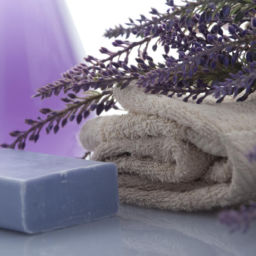Bathroom Bathing Design: 10 Things to Consider-Part I
The smallest room in your home could pose the biggest risk to you and your loved ones.
According to the Centers for Disease Control (CDC) over 235,000 people over 15 years of age are seen in hospital emergency rooms as a result of injuries sustained in the bathroom with 14% of them being hospitalized. (1) More women than men are injured and injuries occurring in the shower or bathtub are the most prevalent. Slipping and losing consciousness are the next highest injuries sustained while performing activities in the bathroom. Those 85 years old and older have the highest occurrence of injuries in the bathroom.
Causes of Injuries over 65
- Falls (81%)
- Other Injuries (19%)
- Falls (81%)
- Other Injuries (19%)
Bathroom Injury Rate by Age, Reported by Hospital Emergency Rooms
- Rate per 100,000
- Rate per 100,000
Activity Leading to Injury
- % of Injury
- % of Injury
Injuries by Sex
- Men 36%
- Women 64%
- Men 36%
- Women 64%
Many of the injuries reported above can be prevented by equipping your bathroom with products and tools to help prevent falls and slips.
Whether you are considering new construction, an addition, a major remodel or even a smaller update to bathroom there are many things to consider to ensure you or your loved ones are safe during their bathroom time. In this article we will explore 10 areas that need to be addressed when equipping your shower or bathtub for a disabled or impaired family member.
We have taken a photo of our recent master bathroom remodel after my wife became disabled. We had to address all her needs to ensure she could safely enter, exit and bathe herself in the new shower. Our contractor was knowledgeable in ADA requirements and our County was very responsive in making sure the work met current building and ADA codes. Each area has been tagged and you can read more about each area by referencing the corresponding number below.


Bath Chair or Bath Transfer Bench
Choosing an appropriate shower or bath seating solution is vital to the safety of your loved one when bathing in the bathroom. Which one should you use and how do you choose one? See our informative article on “Bath chairs for the disabled and elderly-10 things to consider” to help you choose the right chair for your needs.
If you or your loved has difficulty standing in the shower or tub then a chair or bench would be ideal for you. Even if your situation is temporary, perhaps due to knee, hip or back surgery, you should consider a chair until you are well enough to stand on your own again. The importance of safety in the shower or bathtub cannot be understated!
My wife uses a heavy duty (or bariatric) bath transfer chair in our shower. This allows her to comfortable and safely sit in the shower to bathe. The chair comes partially assembled with a snap on back and push button adjustable legs. She chose not to use the backrest so she could easily wash her own back or I can stand behind her to assist in washing. The handle, along with the grab bar, is necessary to help her steady herself when sitting and rising. The chair has the extended cross-brace legs to give her added support for her larger frame. This chair is great for a shower situation, however it will not fit in our older bathtub. (That is part of the reason we decided to remodel our master bathroom and leave the bathtub alone in our main bathroom.) This is something you will need to decide when choosing a chair for your situation.

Grab Bar(s) for Safety
Grab bars are an essential item to use in showers, tubs and around toilet where extra stability is required. If you or a loved one has stability, mobility or transfer problems using bathing or toileting functions in your bathroom, adding strategic grab bars will allow them a sturdy option of steadying themselves while sitting, rising or moving from one area to another. Grab bars are required for any ADA (Americans with Disability Act) certified bathroom.
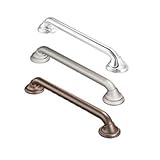 Grab bars come in different sizes, shapes, colors and adherence types. For the purpose of this article color will be the least of our considerations. Color matters when you are trying to establish a style in your bath or toilet areas. You can choose from most color of metals – nickel, chrome, bronze and brass – and vinyl coated bars in white, black and almond. There are many styles and colors to choose from to fit the decor of your bathroom and avoid that institutional look. One concern with color choice might be an allergic reaction to some metals. In that case you may need to choose a vinyl solution. If you choose the vinyl solution make sure it won’t chip, which could allow rust and hurt your hand if scrapped.
Grab bars come in different sizes, shapes, colors and adherence types. For the purpose of this article color will be the least of our considerations. Color matters when you are trying to establish a style in your bath or toilet areas. You can choose from most color of metals – nickel, chrome, bronze and brass – and vinyl coated bars in white, black and almond. There are many styles and colors to choose from to fit the decor of your bathroom and avoid that institutional look. One concern with color choice might be an allergic reaction to some metals. In that case you may need to choose a vinyl solution. If you choose the vinyl solution make sure it won’t chip, which could allow rust and hurt your hand if scrapped.
Grab Bar Mounts
There are three types of grab bars – fixed, suction and tension. The first, and safest in our opinion, is the permanently mounted bar. These are bars that are directly drilled and anchored into your shower, tub and toilet surround walls. They need to be anchored into your studs or additional support material to ensure the bar can hold the desired weight (a minimum of 250 pounds). This can be tricky if working with older bathroom areas or fiberglass wall surrounds. Make sure your contractor is knowledgeable about State and Local building codes and ADA regulations for placement and installation! You do not want the bar to give way when your loved one needs it for support!
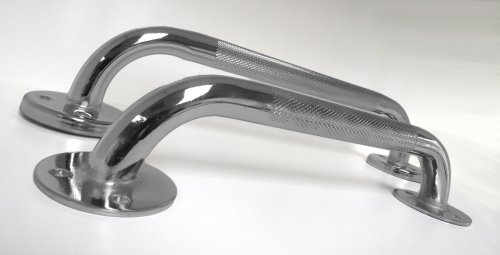 You will need to consider if you want the mounting screws hidden or countersunk into the flange of the bar. Usually the grab bar manufacturer will provide a decorative cover for your bar ends to hide the mounting screws. Consider rust factors and a cutting or scrapping factor of your loved one’s hand(s) if you choose to have the screws exposed. It may be better to have them covered to alleviate these potential problems.
You will need to consider if you want the mounting screws hidden or countersunk into the flange of the bar. Usually the grab bar manufacturer will provide a decorative cover for your bar ends to hide the mounting screws. Consider rust factors and a cutting or scrapping factor of your loved one’s hand(s) if you choose to have the screws exposed. It may be better to have them covered to alleviate these potential problems.
Grab bars should be between 1 1/4″ to 1 1/2″ in diameter and fit your grip comfortably. They ideally should be made of 18 gauge steel tubing for durability. They may or may not have a safety grip for added slip protection (cross-hatched area of bar that is rougher to the touch for additional grip-ability). The bar should not be more than 1 1/2″ from the wall. This will prevent someone’s arm from becoming wedged (or possibly broken) between the bar and wall should they slip and grab for support.
The second form of grab bar are the suction based grab bars. These grab bars are not designed to bear someone’s weight! They are used for someone who needs mild stability assistance getting in and out of the tub. While they have two strong suction cups that are secured with a latching system they cannot and should not be used to put any weight on them! They can easily be detached and reapplied by moving the lever, cleaning the suction heads and applying to a new clean dry area of the wall. They can also be directly applied to a bathtub edge. These grab bars can be installed by anyone and do not require a licensed contractor.
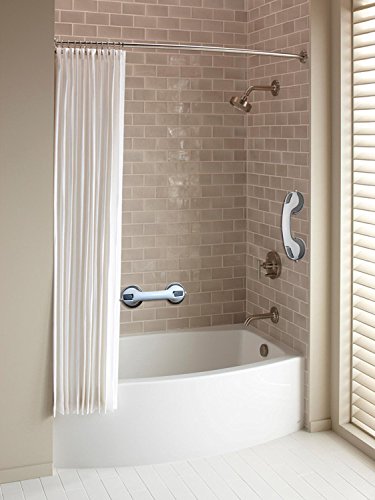 The third form of assistance is a tension grab pole mounted outside the tub or shower. They easily mount to the ceiling and floor using a tension system to hold them in place. Again these poles are not meant to support someone’s weight! They are designed to provide mild stability assistance entering and exiting the tub or shower. The poles are usually height adjustable to match your ceiling height and have a swing arm extension for someone to hang on to for support. The trick to make them effective is to make sure they are properly mounted vertically with enough tension to support use without collapsing. These grab bars can be installed by anyone and do not require a licensed contractor.
The third form of assistance is a tension grab pole mounted outside the tub or shower. They easily mount to the ceiling and floor using a tension system to hold them in place. Again these poles are not meant to support someone’s weight! They are designed to provide mild stability assistance entering and exiting the tub or shower. The poles are usually height adjustable to match your ceiling height and have a swing arm extension for someone to hang on to for support. The trick to make them effective is to make sure they are properly mounted vertically with enough tension to support use without collapsing. These grab bars can be installed by anyone and do not require a licensed contractor.
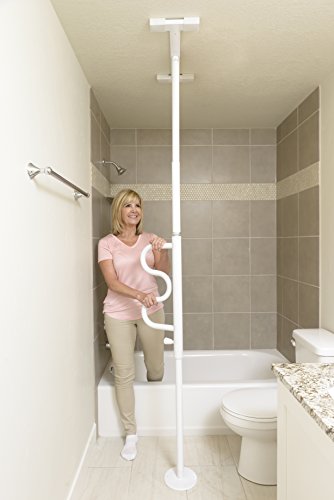
Grab Bar Placement
You cannot place grab bars anywhere you like. There are specific heights and lengths that required for both safety and to meet the ADA needs of your loved one. Here are the guidelines you and your contractor need to follow to meet those requirements.
According to GRABDASHBAR (2), the proper location for grab bars are as follows:
- For toilets (water closets) – not in a stall, 33”-36” off of the finished floor (ADA Section 4.16)
- For toilets – inside a stall, 33”- 36” off of the finished floor (ADA Section 4.17)
- For bath tubs – 3 grab bars are required, two on the back wall (one 9” above the rim of the tub, the other 33” -36” above the finished floor) and the third at the head of the tub (ADA Section 4.20)
- For Shower Stalls – either 2 or 3 grab bars are required, 33” – 36” from the floor of the shower stall. (ADA Section 4.21). The number of grab bars required in a shower stall is dependent on the size of the shower stall.
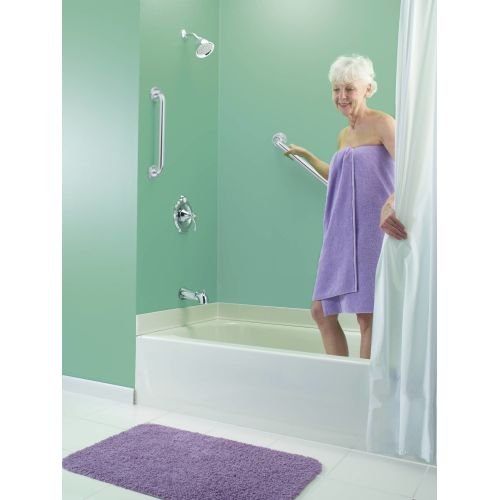 Depending on the room available and your loved one’s needs you may want a horizontal bar, a vertical bar, an angled bar or a combination bar.
Depending on the room available and your loved one’s needs you may want a horizontal bar, a vertical bar, an angled bar or a combination bar.
- Vertical bars are usually used to provide stability entering and exiting tubs and showers and can bear some weight. Some like them at the toilet location too. They are good for arthritic hands and easier to grip. They cannot help someone when rising or sitting and provide significant distance when moving around the tub or shower. Much will depend how you intend to use them and the strength of the person needing them.
- Horizontal bars provide stability rising and sitting if you can bear much of your own weight. They also provide greater safety when moving from around the tub or shower and when rising from a seated position. Greater support for people transferring from a wheelchair into the tub or shower and toilet areas. However, they are limited in height if there are multiple people using the same bathing solution. It may also be uncomfortable on the wrists, especially those with arthritis.
- Angled or diagonal bars are easier for lowering or pulling oneself out of a tub. They also work well with other people who need to use the same bathing situation. It is a good solution for someone using a bench or chair as it provides a more natural means or rising and sitting thus reducing strain on muscles and bones. The down side of this type of bar is the potential for hand slippage as someone pulls them along the bar.
Discuss these options with your medical professional (doctor or physical therapist) and contractor to see what is needed and possible in your bathroom situation.
Personal note: In our shower design we have one long horizontal bar that my wife uses to assist in sitting and standing and one vertical bar to assist her in entering and exiting the shower. It is important to note that the placement of each bar provides safe continuity of movement around a tub or shower is essential! We placed these bars after my wife’s arm reach was measured so we could ensure she could hold one bar while grabbing the second bar.
Above all remember your safety is the number one priority in whatever color and style choice, mounting option and orientation you decide for your bathroom solution!
References:
- (1) – Centers for Disease Control – Morbidity and Mortality Weekly Report (MMWR) – June 10, 2011
- (2) – GRABDASHBAR – https://www.grab-bar.com/pages/frequently-asked-question
We would really like to hear your comments and design ideas you used to make your bathing experience safer and easier. Please leave your comment below.
To your improved health…
Please continue reading more in this series at:



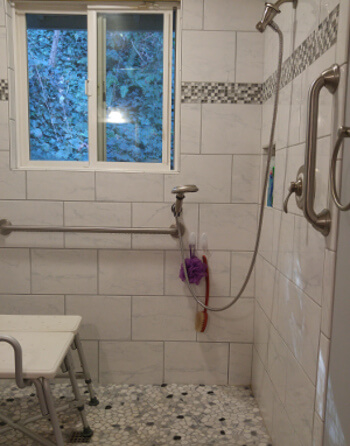
![How to Choose the Best Bath Chair or Transfer Bench [Buying Guide]](https://hallofcare.com/wp-content/uploads/2019/04/Gartner_Bath_Bench-256x256.jpg)
